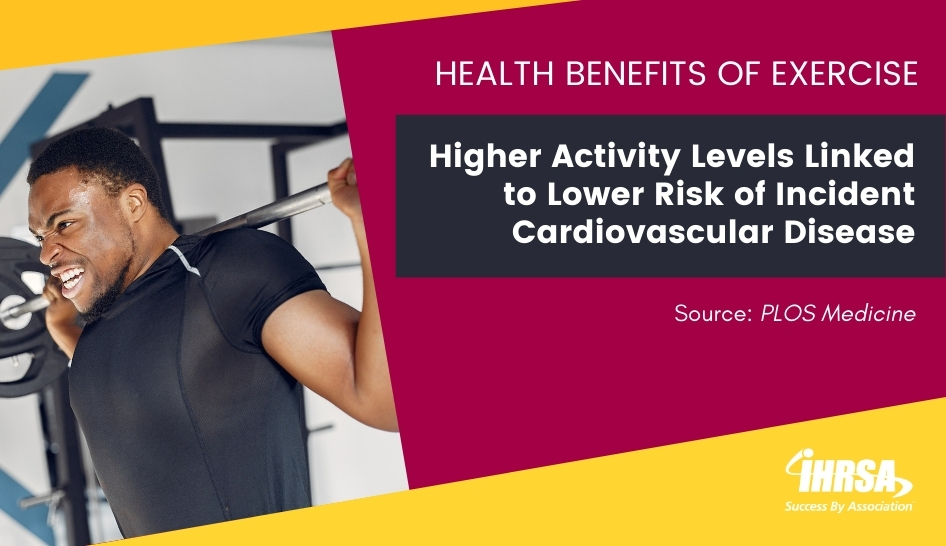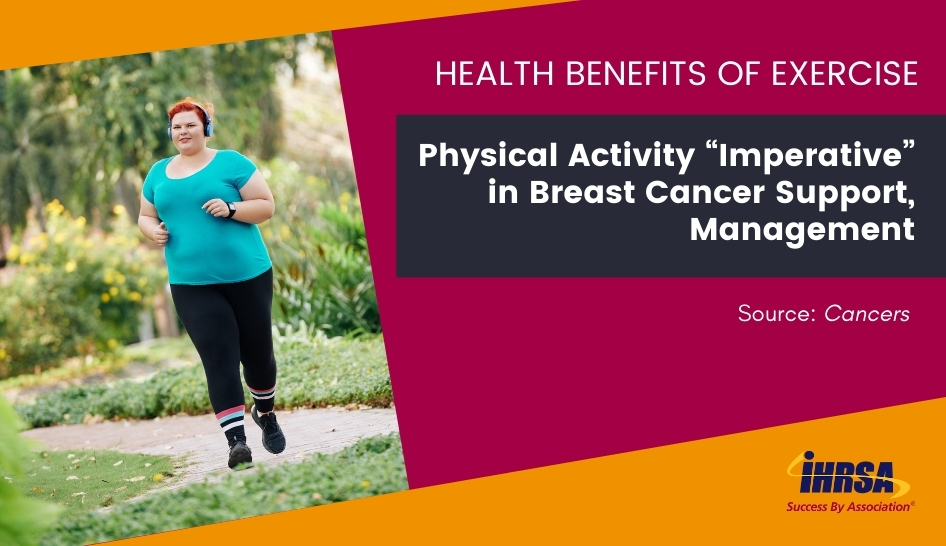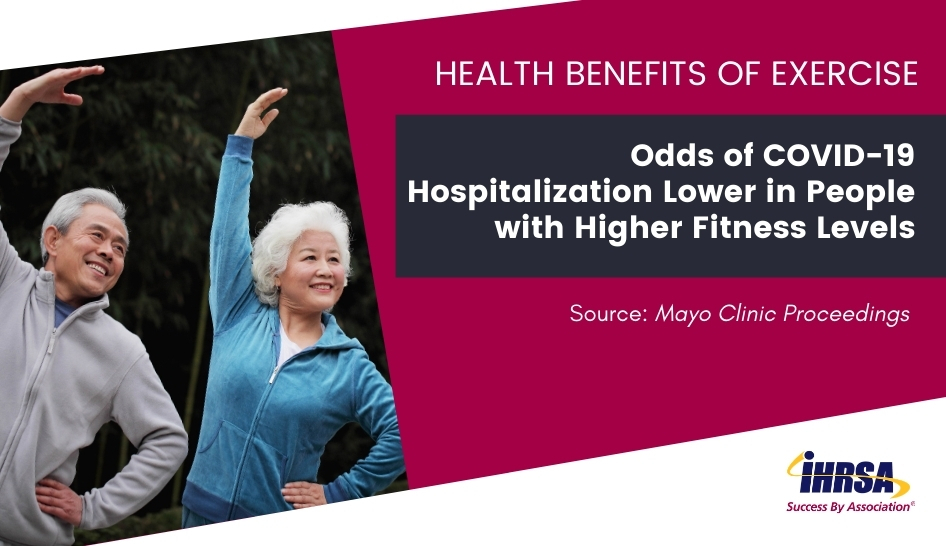The Health Benefits of Exercise Report is a newsletter and article series in which we select three peer-reviewed articles, summarize the key findings, and provide social media images for you to share with your community. You can read previous articles here.
Higher Activity Tied to Lower Risk of Cardiovascular Events
We review three studies that show a link between higher levels of physical activity and incident cardiovascular disease, outline the vital role physical activity plays for breast cancer patients and survivors, and find an association between higher levels of exercise capacity and lower odds of COVID-19 hospitalization.
As the COVID-19 pandemic persists, maintaining a physically active lifestyle continues to present a challenge. As winter sets in—with shorter and colder days in many parts of the world—it can be even harder to be physically active. However, we know that exercise is a key measure to help prevent chronic health conditions that still affect millions of people and increase the risk of severe COVID-19. This month’s edition of the Health Benefits of Exercise Report covers:
- A study finding a link between higher levels of physical activity and incident (hospitalization or death from) cardiovascular disease
- A review outlining the vital role physical activity plays in breast cancer patients and survivors
- An analysis finding an independent association between higher levels of exercise capacity and lower odds of COVID-19 hospitalization

Higher Activity Levels Linked to Lower Risk of Incident Cardiovascular Disease
A study published in PLOS Medicine examined the relationship between objectively measured moderate and vigorous physical activity, total physical activity, and cardiovascular disease hospitalization or death. Researchers analyzed data on 90,211 people in a subset of a British genetics study cohort who had worn an accelerometer for a week between 2013 and 2015 and for whom information on additional factors including age, sex, and education was available.
According to the findings, people in the lowest activity categories were also more likely to have other health risks, including:
- a higher BMI,
- more smoking,
- slightly higher alcohol use,
- hypertension, and
- increased hemoglobin A1C levels—a longer-term measurement of blood glucose.
The analysis found a dose-response, linear relationship between moderate, vigorous, and total physical activity and risk of heart disease hospitalization or death. Findings did not differ between different types of cardiovascular disease or by gender.
The study also found no threshold, or upper limit, for the benefit of physical activity on incident cardiovascular disease, meaning higher levels of exercise did not have diminishing returns. The authors note this “aligns with the recommendations of the UK Chief Medical Officer’s report on [physical activity] that ‘some physical activity is good but more is better.’”

Physical Activity “Imperative” in Breast Cancer Support, Management
Studies have shown a beneficial link between physical activity and breast cancer prevention and management. A review published in the journal Cancers outlines the evidence supporting physical activity to support different breast cancer treatments and its role in improving quality of life. It argues that physical activity is central to the treatment and management of breast cancer.
Current evidence suggests as many as 90-95% of all cancer cases are related to lifestyle or environmental factors. Specific to breast cancer, data suggest 1 in 4 cases may be preventable with lifestyle management. Among active women, researchers observed a 25% reduction in breast cancer risk compared to inactive women. Risk reduction differs by age, menopausal status, and hereditary factors.
Studies also underline the importance of physical activity in breast cancer patients due to its beneficial effects on survival, mortality, and prognosis. Physical activity can also help manage comorbidities linked to breast cancer, including cardiovascular disease, lymphedema, and cognitive dysfunction. It can also have a positive impact on quality of life.
Both aerobic and resistance training, as well as combined aerobic and resistance training can be effective for women with breast cancer. Evidence does not suggest enhanced benefits for a longer duration or higher volumes of aerobic and resistance training. When creating a training plan for breast cancer patients, professionals should consider factors like:
- cancer-related symptoms,
- environmental barriers such as time or cost,
- motivation,
- knowledge and self-efficacy, and
- fitness history.
The authors also recommend using physical activity trackers, accelerometers, and other wearable devices to track physical activity, which can help determine the most effective programs.
The authors conclude by noting, “It is essential to understand that [physical activity] is another part of a great and complex puzzle. [Physical activity], along with other lifestyle interventions, did not cure [breast cancer] by itself, but it entails an imperative additional support to maximize the rate of success in [breast cancer] management.”

Odds of COVID-19 Hospitalization Lower in People with Higher Fitness Levels
Several studies published in the past year have pointed to a link between certain lifestyle habits—physical inactivity, smoking, and obesity—and an increased risk of severe COVID-19, including hospitalization, mechanical ventilation, and death. A study published in Mayo Clinic Proceedings sheds new light on lifestyle and COVID-19 by looking at the association between higher objectively measured fitness levels and COVID-19 outcomes. The study, conducted at the Henry Ford Health System in Michigan, analyzed data on over 1,100 patients who had completed a medically recommended exercise stress test within the past five years and a SARS-COV-2 test.
The analysis found an independent association between maximal exercise capacity and COVID-19 hospitalization, namely that peak exercise capacity was lower among hospitalized versus non-hospitalized patients. There was no association between exercise capacity and the likelihood of contracting COVID-19. Odds of hospitalization were over three times higher among the group with the lowest compared to the highest peak exercise capacity. In addition, each unit increase in peak exercise capacity—measured by metabolic equivalents or METs—was associated with a 13% reduction in the likelihood of hospitalization, though this effect tapered off at higher fitness levels.
An interesting thing about this study is that it was conducted in a group inclined toward a higher risk of more severe COVID-19 outcomes. All of the analysis participants had a medical reason to have an exercise stress test, with a majority referred for:
- chest pain,
- shortness of breath or fatigue,
- an abnormal ECG or functional study, and
- heart failure evaluation.
The group also trended older, with ages ranging from 47 to 71 at the time of their SARS-COV-2 test.
In their conclusion, the authors note, “These data further support the important relationship between cardiorespiratory fitness and health outcomes. Patients should be encouraged to regularly engage in aerobic exercise to maintain or to improve their exercise capacity.”

Alexandra Black Larcom, MPH, RD, LDN, previously served as IHRSA's Senior Manager of Health Promotion & Health Policy—a position dedicated to creating resources and projects to help IHRSA members offer effective health programs, and promoting policies that advance the industry.